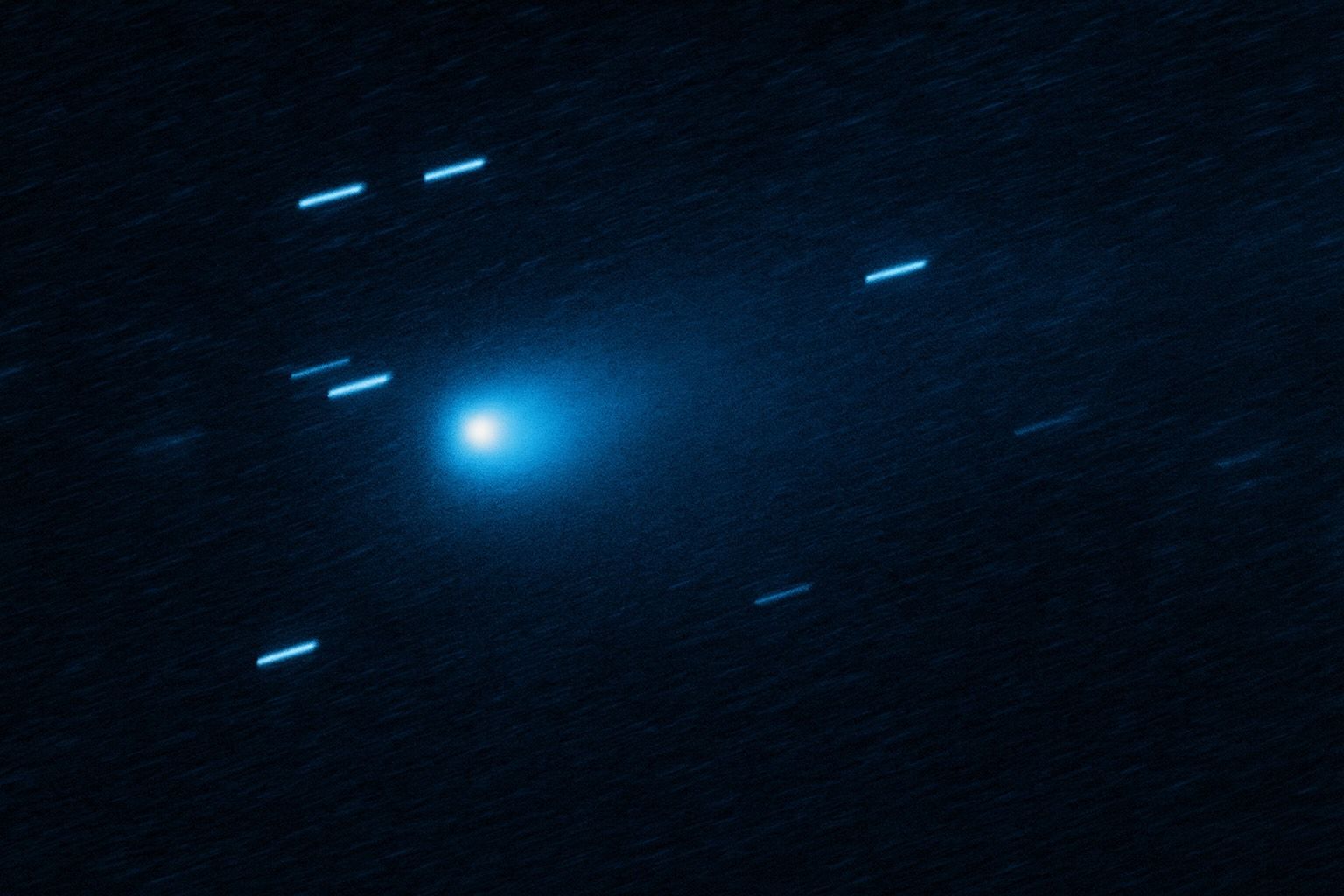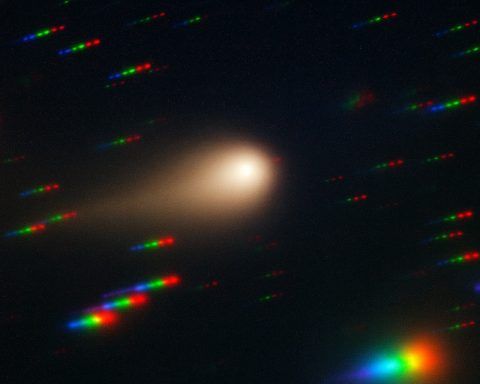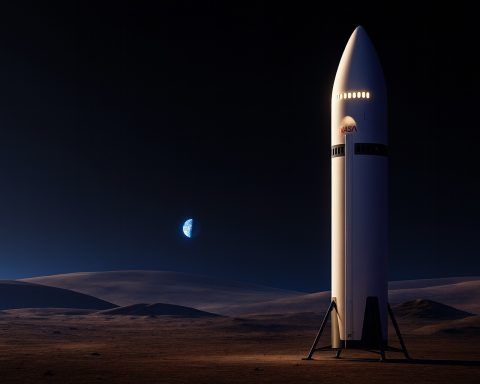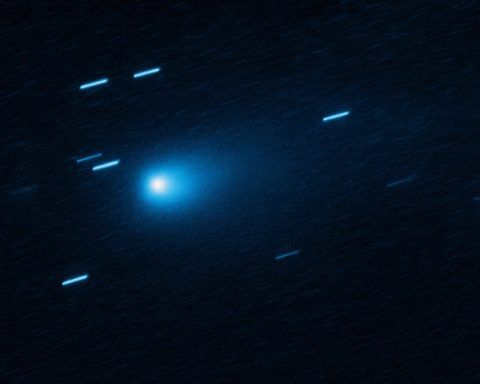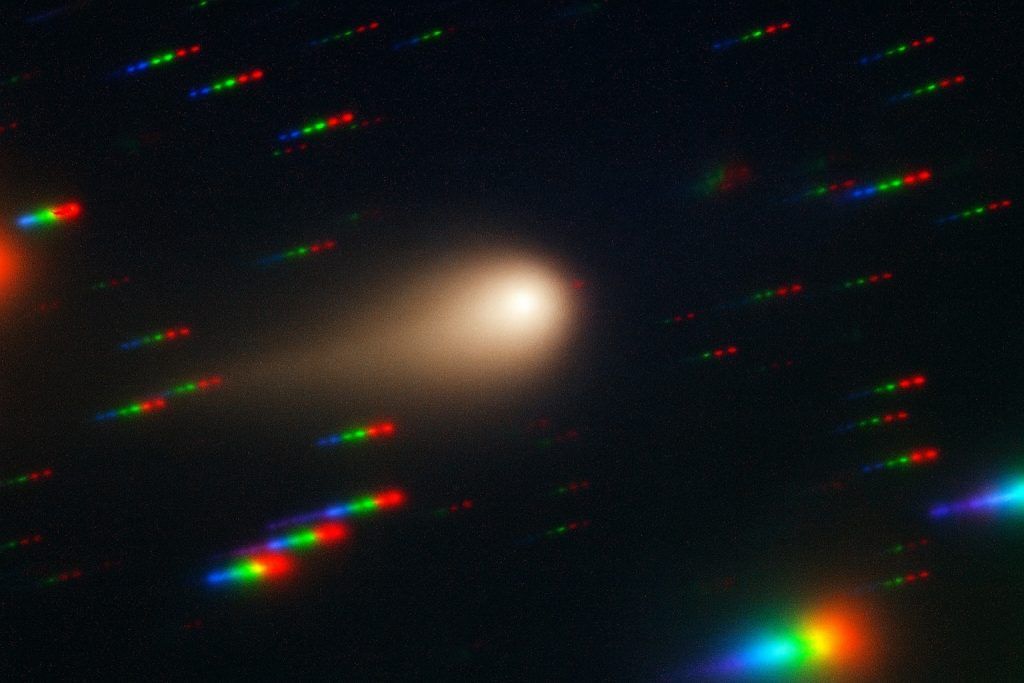- Third Interstellar Visitor: Comet 3I/ATLAS is only the third known object from beyond our solar system, following 2017’s 1I/‘Oumuamua and 2019’s 2I/Borisov [1]. It was discovered on July 1, 2025 by the NASA-funded ATLAS sky survey in Chile [2], immediately recognized for its hyperbolic (escape) trajectory [3].
- Near-Sun Flyby This Week: 3I/ATLAS is racing toward its closest approach to the Sun (perihelion) on October 29–30, 2025. It will swing inside Mars’s orbit at about 1.36–1.4 AU (~130 million miles) from the Sun [4] [5] – unfortunately on the far side of the Sun from Earth’s viewpoint, making it unobservable during the exact flyby. Its closest pass by Earth will be ~1.8 AU in December 2025, so it poses no danger (and won’t be visible to the naked eye).
- Speeding on a One-Way Trip: This comet is hurtling through the inner solar system at an extraordinary 130,000+ mph (~58 km/s) [6]. It isn’t gravitationally bound to the Sun – instead following an open, hyperbolic orbit that will carry it back into interstellar space after this encounter [7]. This extreme speed and path are telltale signs of its interstellar origin.
- Record-Breaking Size: Astronomers believe 3I/ATLAS is the largest interstellar object ever detected. Initial observations suggest a nucleus possibly up to 5–10 km (3–6 miles) across [8] [9] – orders of magnitude bigger than ‘Oumuamua (estimated just a few hundred meters) or Borisov (~1 km). The Hubble Space Telescope snapped the comet in July and set an upper limit of ~5.6 km diameter [10]. Its large size and resulting brightness have made 3I/ATLAS easier to study than its predecessors.
- Ancient Time Capsule: Based on its trajectory through the Milky Way, 3I/ATLAS likely hails from the galaxy’s “thick disk” – a sparse population of very old stars high above the galactic plane [11] [12]. Researchers say this comet could be 7–11 billion years old, possibly the oldest comet ever observed (around 3 billion years older than our 4.6-billion-year-old Solar System) [13] [14]. In other words, 3I/ATLAS may have formed long before our Sun existed, preserving primordial materials from a bygone cosmic era.
- “Fire Hose” of Water: 3I/ATLAS has been unusually active even while far from the Sun. NASA’s Swift space telescope detected it blasting out an estimated 88 pounds (40 kg) of water per second – “about the equivalent of a fire hose running at full blast” – when it was still 2.9 AU from the Sun [15]. Such vigorous outgassing at nearly three times Earth’s distance is surprising, since water ice usually stays frozen until a comet comes much closer to the Sun.
- Carbon Dioxide & Heavy Metals: Observations show the comet’s fuzzy coma (gas halo) is rich in carbon dioxide gas and water vapor but contains little carbon monoxide [16] [17]. This suggests 3I/ATLAS “was well baked and boiled” in its original star system, having lost its most volatile ices long ago [18]. In a surprising discovery, scientists even detected glowing nickel vapor in the comet’s gas – at a distance so cold that metals don’t normally sublimate [19]. The presence of vaporized heavy elements at this range provides new clues to the comet’s chemistry and long interstellar journey.
- Global Science Campaign: Telescopes around the world – and above it – are training their eyes on 3I/ATLAS. Hubble and the James Webb Space Telescope have both observed it [20], as have major observatories like Gemini and the VLT. Even spacecraft at Mars got in on the action: in early October, ESA’s ExoMars TGO orbiter snapped the comet’s coma from ~30 million km away [21]. Coming up, ESA’s JUICE probe (near Jupiter) and NASA’s Psyche spacecraft (between Earth and Mars) are poised to observe 3I/ATLAS near perihelion from advantageous angles [22] [23]. Scientists call this “literally a once-in-a-lifetime opportunity” to study an interstellar comet up close [24].
Image: Interstellar comet 3I/ATLAS (center) streaking through the stars, captured on Aug. 27, 2025 by the Gemini South telescope in Chile. As the comet nears the Sun, solar radiation vaporizes ice in its nucleus, unleashing jets of gas and dust that form a growing tail [25].
A Visitor From Beyond the Solar System
Astronomers in late July 2025 realized that a faint new comet spotted by the ATLAS survey was no ordinary object – its orbit was highly eccentric (e > 1), meaning it wasn’t bound to the Sun at all [26]. This was the tip-off that the comet, now designated 3I/ATLAS, came from interstellar space. The “3I” label itself indicates the third interstellar object ever recorded, after the famous cigar-shaped 'Oumuamua in 2017 (1I) and comet 2I/Borisov in 2019 [27]. Unlike all planets, asteroids, and regular comets which loop around the Sun, 3I/ATLAS is on a one-time hyperbolic swing through our Solar System, set to never return [28].
Discovered on July 1, 2025 by an Asteroid Terrestrial-impact Last Alert System (ATLAS) telescope in Río Hurtado, Chile, the comet was first logged as C/2025 N1 (ATLAS) [29]. Within days, its trajectory was confirmed as interstellar – a thrilling development for scientists. “When 3I/ATLAS was announced, [one researcher] was set to go on holiday. Instead, he found himself comparing real-time data to his predictions,” a Royal Astronomical Society release noted, reflecting the excitement in the astronomy community [30] [31]. At discovery, 3I/ATLAS lay about 4.5 AU out (beyond Jupiter) and already showed signs of activity [32], which immediately set it apart from 'Oumuamua (which never produced a visible coma).
“This is an object from a part of the galaxy we’ve never seen up close before,” says astrophysicist Chris Lintott of the University of Oxford, a member of one team studying the comet [33]. Its steep incoming path suggests it originated in the Milky Way’s thick disk, an ancient stellar population well above the galactic plane [34]. In fact, astronomers say 3I/ATLAS is ‘very likely to be the oldest comet we have ever seen’ [35] – potentially formed billions of years before our Sun and flung into interstellar exile around a distant, long-lived star. That makes this visitor a priceless time capsule from the early universe. “They’re like cosmic time capsules, delivering samples from distant exoplanetary systems we could never otherwise visit,” noted one scientific commentary [36].
How 3I/ATLAS Compares to ‘Oumuamua and Borisov
Each interstellar interloper so far has been startlingly different, giving astronomers a tiny but tantalizing sample of the diversity of other star systems. The first, 1I/‘Oumuamua, was extremely odd – a small, tumbling object with no coma or tail, likely rocky or ice-free, that sped up slightly for mysterious reasons (scientists suspect outgassing, though none was directly seen). Some even speculated ‘Oumuamua might be artificial, but the prevailing view today is that it was a fragment of a Pluto-like exoplanet – essentially an “exo-Pluto” icy shard with unusual geometry [37] [38].
By contrast, 2I/Borisov (discovered in 2019 by an amateur astronomer) behaved much more like a normal comet, complete with a visible tail. Borisov was deemed relatively pristine – essentially an “untouched” comet from another solar system’s Oort Cloud. It was rich in carbon monoxide (CO) and other volatiles, implying it formed in a cold outer region of its home system.
Now 3I/ATLAS has arrived, and it’s unlike either predecessor. It’s far larger and more massive – potentially by a factor of ten or more – and already active while still distant. “Every interstellar comet so far has been a surprise,” says Zexi Xing, an astronomer at Auburn University who has been observing 3I/ATLAS. “’Oumuamua was dry, Borisov was rich in carbon monoxide, and now ATLAS is giving up water at a distance where we didn’t expect it. Each one is rewriting what we thought we knew about how planets and comets form around stars.” [39] In other words, these cosmic visitors are teaching us that planet-forming environments vary widely. Ingredients and behaviors that we take for granted in our Solar System (like when water ice starts sublimating, or how big comets typically are) may play out very differently elsewhere.
Notably, 3I/ATLAS seems to have formed in a much older environment than Borisov or anything in our system. Its thick-disk origin and high speed (nearly 60 km/s, roughly double Borisov’s velocity) point to an object that has been traveling the galaxy for eons [40] [41]. One analysis gives a 68% probability that 3I/ATLAS is older than the Solar System itself [42] – perhaps 8–10 billion years old. By contrast, ‘Oumuamua and Borisov likely came from younger, more chemically “fresh” systems. If 3I/ATLAS truly formed around an ancient star, it might carry chemical imprints from the Milky Way’s early days (astronomers even dubbed it a messenger from “cosmic noon,” a period of vigorous star formation billions of years ago [43]).
Another big difference is observational: thanks to its relative brightness, 3I/ATLAS has been caught early and tracked continuously for months, whereas ‘Oumuamua was spotted only on its way out. “This new visitor…was caught early in its journey through our solar system, giving astronomers an unprecedented opportunity to watch an interstellar comet come to life as it approaches the Sun,” wrote scientists R. Rahatgaonkar and D. Seligman [44] [45]. For the first time, we can study the evolution of such an object in real time, rather than piecing together clues after the fact.
Journey Through Our Solar System: Trajectory & Timeline
After entering the Solar System from above the plane of planets, 3I/ATLAS is now barreling toward perihelion on Oct. 29. It will skim about 1.4 astronomical units from the Sun – roughly midway between Earth’s and Mars’s orbits [46]. While that’s not extremely close to the Sun, the geometry is unfortunate for skywatchers on Earth. “3I/ATLAS will reach its closest point to the Sun behind the Sun, if viewed from Earth,” explains astronomer Andreas Hein [47] [48]. Essentially, during its critical peak activity, the comet will be obscured by solar glare. “We would need to look through or past the Sun to observe 3I/ATLAS… a big issue, as the Sun is very bright and 3I/ATLAS is very faint. We would not be able to see it from Earth,” Hein notes [49] [50].
Indeed, our planet is poorly situated for this visitor’s closest approach. As 3I/ATLAS loops around the Sun, it will emerge from conjunction in November, but by then it will be receding. Its closest approach to Earth occurs on Dec. 19, 2025 at a distance of ~1.68 AU (251 million km) [51] – far too distant to pose any hazard. Observers with mid-sized telescopes might catch the comet as a faint smudge in late 2025 and early 2026 [52], but it won’t be a spectacle like a bright naked-eye comet. (Meanwhile, a completely unrelated Comet Lemmon has been lighting up Earth’s skies – providing a cosmic consolation prize of sorts [53].)
After New Year 2026, 3I/ATLAS will depart the inner Solar System for good, heading back into the interstellar void. Its outbound trajectory should take it above the plane of the Solar System and eventually into intergalactic space (unless it happens to enter another star’s sphere of influence in a few million years). In essence, humanity has only a brief few-month window to study this ancient wanderer before it’s gone forever. That fleeting opportunity is why astronomers have mounted a global observation campaign at a scale never seen for a comet.
Comet 3I/ATLAS Springs to Life
One of the most exciting aspects of 3I/ATLAS has been witnessing its coma and tail develop as it nears the Sun. Initially, when the comet was still beyond Jupiter’s orbit, it appeared as a dim “fuzzy star” with a slight haze. But by late August 2025, images showed a growing tail of ejected dust and gas. The Gemini South telescope in Chile captured one of the clearest early views on Aug. 27, revealing a streaking comet head and a faint tail against trailed background stars [54]. “As 3I/ATLAS zooms closer to the Sun, radiation from our star heats the ice on the comet’s body (its nucleus), causing geysers of gas and dust that create a glowing coma and tail,” Live Science explained [55]. In other words, 3I/ATLAS began “waking up” – transitioning from a dormant iceball into an active comet spewing material.
What astonished scientists was how soon this activity ramped up. NASA’s Neil Gehrels Swift Observatory detected the signature of water vapor (indirectly, via hydroxyl radicals OH) coming off 3I/ATLAS when it was nearly 3 AU from the Sun [56] [57] – around the orbit of the asteroid belt. That’s roughly twice the distance at which water ice typically starts sublimating on comets [58] [59]. The Swift team calculated the comet was losing on the order of 40 kg of water per second into space at that time [60] [61], prompting co-author Dennis Bodewits to marvel at the implications: “When we detect water – or even its faint ultraviolet echo, OH – from an interstellar comet, we’re reading a note from another planetary system,” Bodewits said. “It tells us that the ingredients for life’s chemistry are not unique to our own.” [62] [63] In other words, the water and organic molecules we see being shed by 3I/ATLAS carry a message: distant star systems have the same building blocks for life scattered among their comets.
The comet’s hyperactivity far from the Sun suggests it may have a wealth of super-volatile ices or an easily heated surface. Sure enough, early observations by JWST hinted at an unusually high CO₂-to-H₂O ratio in the coma [64]. Then, in September, NASA’s new SPHEREx space telescope (an infrared survey mission) confirmed “an abundance of carbon dioxide gas in the fuzzy coma… as well as water ice in the nucleus” [65]. Notably, carbon monoxide (CO) was absent or very low [66] [67]. This composition is a crucial clue: CO is the most easily lost ice (boils at the lowest temperature), CO₂ is intermediate, and H₂O is comparatively harder to vaporize. The apparent lack of CO alongside plentiful CO₂ and H₂O tells scientists that 3I/ATLAS has been thermally processed over time. “SPHEREx’s finding of very large amounts of vaporized carbon dioxide gas around 3I/ATLAS told us it could be like a normal solar system comet,” says Carey Lisse, a Johns Hopkins University scientist on the SPHEREx team [68] [69]. Comets born in the outskirts of a planetary system tend to have all three ices (H₂O, CO₂, CO) in abundance, but if one spent eons closer to a star or was heated internally, it would lose the most volatile components first [70]. “3I/ATLAS is behaving like a normal, well-thermally processed… cometary object,” Lisse explains – essentially, it seems “well baked” by its parent sun already [71]. That aligns with the idea that it came from an older star system where it either formed closer to the star or migrated inward before being ejected.
On top of water and carbon dioxide, 3I/ATLAS has yielded another astonishing find: heavy metal in its vapor. In October, a team using the European Southern Observatory’s Very Large Telescope announced they had detected nickel (Ni) gas in the comet’s coma [72] [73]. Metallic nickel atoms were identified via their spectral lines, despite the comet still being several hundred million kilometers from the Sun – a region far too cold for nickel to normally sublimate. How is this possible? Researchers aren’t yet sure. A similar phenomenon was observed in comet 2I/Borisov (traces of nickel and iron gases were found in its coma at cold distances, puzzling astronomers) [74] [75]. One hypothesis is that extremely fine dust grains or organic compounds in the comet could be releasing a trickle of heavy atoms even in the cold, a process that only sensitive spectra can detect [76] [77]. Regardless, the presence of nickel confirms that 3I/ATLAS carries rocky material in addition to ices – a true mix of primordial ingredients from its home system. “The chemical signatures we’re observing may reflect both the comet’s ancient origins and its long journey through interstellar space,” wrote Rahatgaonkar and Seligman, whose team made the nickel discovery [78] [79].
An All-Hands-On-Deck Science Campaign
To capitalize on this “once-in-a-lifetime” visitor, astronomers have marshaled an impressive array of observatories. Ground-based telescopes across the globe have been tracking 3I/ATLAS nightly, from large research instruments to amateur setups. Four ATLAS survey telescopes (in Hawaii, Chile, and South Africa) monitored it early on [80], and major observatories like Gemini North & South, VLT, Subaru, Pan-STARRS, and others have captured images and spectra. In September, the Hubble Space Telescope obtained high-resolution views, helping to constrain the comet’s size (by measuring the light reflected from its nucleus) [81] [82]. JWST also observed 3I/ATLAS in infrared, which is how the unusual CO₂ dominance was first noticed [83]. These observations not only unveil composition but also monitor for any changes like fragmentation – there’s always a chance an active comet could break apart as it nears the Sun.
In a unique twist, spacecraft around other planets have joined the campaign. On October 3, when 3I/ATLAS passed about 30 million km from Mars, ESA’s Mars Express and ExoMars Trace Gas Orbiter turned their cameras toward the comet [84] [85]. ExoMars TGO managed to image a “fuzzy white dot” moving against the stars – the comet’s nucleus plus coma [86]. It couldn’t resolve the nucleus (that would be like trying to see a cellphone on the Moon from Earth, as the principal investigator noted) [87] [88]. But the diffuse coma, a few thousand kilometers across, was clearly visible as a halo of dust [89]. Mars Express’s attempt was more challenging due to shorter exposure limits, but scientists are stacking images to try to tease out the comet [90]. They also attempted to collect spectra of 3I/ATLAS’s coma using orbiter instruments, which could reveal specific gases present [91]. It’s not yet known if those spectra succeeded, given the faintness. Still, the fact that human-made spacecraft on Mars captured an interstellar comet is a remarkable milestone. “It’s always extra exciting to see them responding to unexpected situations like this one,” said Colin Wilson, ESA project scientist for Mars Express/ExoMars. “I look forward to seeing what the data reveals following further analysis.” [92] [93]
Coming up, attention shifts to spacecraft in the inner Solar System. NASA’s Parker Solar Probe and the SOHO observatory (which watches the Sun) may catch glimpses of 3I/ATLAS’s tail as it swings around the Sun [94]. More intriguingly, two deep-space missions are in prime position: NASA’s Psyche probe (currently en route to asteroid 16 Psyche) will be about 28 million miles from 3I/ATLAS at perihelion, and ESA’s JUICE (Jupiter Icy Moons Explorer) will be ~43 million miles away [95]. Both should be able to point instruments at the comet. “Thanks to its Venus gravity assist on Aug. 31, JUICE will be in the best position for the important period around 3I/ATLAS’s perihelion, when observations from Earth will be the hardest,” says T. Marshall Eubanks, Chief Scientist at Space Initiatives Inc. [96] [97]. JUICE’s cameras and spectrometers, designed to study Jupiter’s environment, can be repurposed to monitor the comet’s activity as it reaches peak heating. Meanwhile at Mars, several orbiters (MAVEN, Mars Reconnaissance Orbiter, China’s Tianwen-1, UAE’s Hope) also have vantage points and capable instruments, and some may attempt observations around the same time [98] [99]. Eubanks believes data from JUICE, in particular, “is likely to be the most critical” for studying 3I/ATLAS’s outburst near the Sun [100] [101].
One daring idea is that a spacecraft might even fly through the comet’s tail to sample its material. Eubanks and colleagues identified that as a possibility: “The Europa Clipper, Hera, and Lucy spacecraft will all be exterior to 3I/ATLAS… they may pass through its tail or observe it at closer distance,” notes Andreas Hein [102] [103]. However, this depends on how the comet’s tail is oriented and spread. If any spacecraft does inadvertently sweep through the tail’s diffuse particles, it could provide a bonus science opportunity – essentially sniffing interstellar dust and gas first-hand. Even without direct sampling, remote observations from multiple angles (Earth, Mars, space probes) will allow 3D reconstruction of the comet’s coma and tail structure.
Why 3I/ATLAS Matters for Science
Beyond the immediate excitement of “alien” visitors, studying interstellar objects like 3I/ATLAS has profound scientific implications. These bodies are messengers from other stars, delivering information about the composition and conditions of distant planetary systems. In the past, our knowledge of exoplanetary materials was mostly indirect (starlight spectra, meteorites, etc.). But an interstellar comet is a chunk of another solar system, dropped on our doorstep. “It’s like an aeon-old fridge, which will open during the next months to release some of its contents,” quipped one scientist, eager to see what secrets 3I/ATLAS’s outgassing might reveal [104].
Already, 3I/ATLAS has confirmed that common volatiles like water and CO₂ exist in other systems’ comets, and in similar proportions to ours [105] [106]. This bolsters the idea that the chemistry that led to life’s ingredients on Earth (water, organics, etc.) is widespread. The comet’s early, intense activity also hints that many star systems could eject objects that are “pre-activated” – meaning they’ve been heated enough to shed volatiles before even entering our Solar System. If true, interstellar comets might often arrive with striking comas, not as inert dark rocks. Each new object we find will help refine these conclusions. “There’s almost always one within the solar system,” some astronomers now argue, regarding interstellar objects [107]. They estimate that at any given time, one or more interstellar vagabonds could be quietly passing through the outer Solar System [108] – most just too faint to notice. The discovery of 3I/ATLAS, so soon after ‘Oumuamua and Borisov, supports that idea that such visitors might be fairly common [109] [110].
The diversity of 1I, 2I, and 3I has energized plans to actively intercept a future interstellar object. In 2029, the European Space Agency will launch the Comet Interceptor mission [111]. Initially it will wait in space (at a Sun-Earth Lagrange point) for a suitable target – ideally a new comet fresh from the Oort Cloud, or perhaps, as ESA notes, “unlikely but highly appealing, an interstellar object like 3I/ATLAS.” [112] The idea is to have a probe ready to sprint toward any newly discovered visitor and study it up close. “When Comet Interceptor was selected in 2019, we only knew of one interstellar object – ‘Oumuamua,” recalls Michael Küppers, ESA’s project scientist for the mission. “Since then, two more such objects have been discovered, showing large diversity in their appearance. Visiting one could provide a breakthrough in understanding their nature.” [113] Even if Comet Interceptor never gets an interstellar target (it might “settle” for an Oort Cloud comet), it will pave the way for rapid-response missions in the future, which could chase down the next 3I/ATLAS. Experts note it’s statistically just a matter of time before we find another interstellar interloper on a trajectory that we can reach with a spacecraft [114]. Each discovery informs how we design these missions – for example, knowing 3I/ATLAS is large and active might influence what instruments and shielding an interceptor spacecraft carries.
And what about those wild speculations of alien technology? Almost inevitably, whenever an unusual interstellar object is spotted, the internet and even some scientists will muse, “Could it be an extraterrestrial probe?” With ‘Oumuamua’s bizarre behavior, such ideas flourished in media. For 3I/ATLAS, early on there was a “controversial paper” suggesting the comet might be “possibly hostile alien tech in disguise”, echoing the ‘Oumuamua debates [115]. However, the data gathered over the past few months strongly points to a natural explanation. 3I/ATLAS’s observed composition – water, CO₂, dust, etc. – is completely typical of an icy comet [116] [117]. Its large size and trajectory match a heavy object that was tugged by gravity, not a maneuvering spacecraft. As Carey Lisse put it, the comet appears to be “a normal, natural solar system cometary object” in behavior [118]. In short, while it’s fun to imagine an interstellar visitor being an alien ship, all evidence indicates 3I/ATLAS is no alien artifact but rather an ancient chunk of ice and rock. And that’s still incredibly exciting – it means nature has provided us an untouched sample of another star’s leftovers to study.
Final Thoughts
As Comet 3I/ATLAS loops around the Sun this week and begins its long voyage back to the stars, astronomers will be watching intently, squeezing as much information as possible out of this rare event. In a sense, humanity is for the first time conducting a “flyby” of an interstellar comet – not with one spacecraft, but with dozens of telescopes and instruments across the Solar System. Each dataset, from Hubble’s high-res images to Mars orbiters’ snapshots to JUICE’s forthcoming observations, adds a piece to the puzzle of what 3I/ATLAS is made of and where it came from.
It’s humbling to realize that the icy dirtball now visiting us may have formed billions of years ago around an alien sun, then wandered the galaxy for ages before chance sent it our way. In its brief visit, it’s confirming that the chemistry of life is likely universal – water, carbon, and even complex organics are probably sprinkled throughout the cosmos on comets like this one [119] [120]. It’s also teaching us to expect the unexpected: every interstellar traveler might look a bit different, hinting at the diversity of worlds beyond our own.
Researchers are already buzzing about what they might find as they analyze 3I/ATLAS’s data for years to come. And with improved sky surveys (and perhaps new missions ready to launch on short notice), we might not have to wait decades for the next interstellar comet. “Hence, observing 3I/ATLAS is a literal example of: If the prophet cannot go to the mountain, let the mountain come to the prophet,” quipped Andreas Hein regarding the scientific opportunity [121]. Indeed, the universe has sent us a visitor – and it’s up to us to learn as much as we can before this ancient wanderer sails back into the darkness between the stars.
Sources:
- ESA News – ESA’s ExoMars and Mars Express observe comet 3I/ATLAS [122] [123]
- Live Science – P. Pester, Comet 3I/ATLAS losing water ‘like a fire hose’… [124] [125]
- Live Science – B. Specktor, Interstellar object 3I/ATLAS is about to get very active [126] [127]
- Space.com – R. Lea, Interstellar comet 3I/ATLAS could be investigated by spacecraft [128] [129]
- Space.com – S. Waldek, Comet 3I/ATLAS wrapped in carbon dioxide fog [130] [131]
- Space.com – R. Rahatgaonkar & D. Seligman, Nickel detection in 3I/ATLAS (Expert Voices) [132] [133]
- ScienceAlert – M. Starr, Fuzzy, Large, And Very Old: Everything We Know About 3I/ATLAS [134] [135]
- Royal Astronomical Society – Interstellar object may be oldest comet ever seen [136] [137]
References
1. www.esa.int, 2. www.space.com, 3. www.space.com, 4. www.sciencealert.com, 5. science.nasa.gov, 6. www.livescience.com, 7. www.space.com, 8. www.livescience.com, 9. www.sciencealert.com, 10. www.livescience.com, 11. www.space.com, 12. www.esa.int, 13. www.space.com, 14. www.livescience.com, 15. www.livescience.com, 16. www.space.com, 17. www.space.com, 18. www.space.com, 19. www.space.com, 20. www.space.com, 21. www.esa.int, 22. www.space.com, 23. www.space.com, 24. www.space.com, 25. www.livescience.com, 26. www.space.com, 27. www.esa.int, 28. www.space.com, 29. www.space.com, 30. ras.ac.uk, 31. ras.ac.uk, 32. www.sciencealert.com, 33. www.sciencealert.com, 34. ras.ac.uk, 35. ras.ac.uk, 36. www.space.com, 37. www.space.com, 38. www.space.com, 39. www.livescience.com, 40. www.sciencealert.com, 41. www.sciencealert.com, 42. ras.ac.uk, 43. www.space.com, 44. www.space.com, 45. www.space.com, 46. www.sciencealert.com, 47. www.space.com, 48. www.space.com, 49. www.space.com, 50. www.space.com, 51. www.space.com, 52. ras.ac.uk, 53. www.livescience.com, 54. www.livescience.com, 55. www.livescience.com, 56. www.livescience.com, 57. www.livescience.com, 58. www.livescience.com, 59. www.livescience.com, 60. www.livescience.com, 61. www.livescience.com, 62. www.livescience.com, 63. www.livescience.com, 64. www.livescience.com, 65. www.space.com, 66. www.space.com, 67. www.space.com, 68. www.space.com, 69. www.space.com, 70. www.space.com, 71. www.space.com, 72. www.space.com, 73. www.space.com, 74. www.space.com, 75. www.space.com, 76. www.space.com, 77. www.space.com, 78. www.space.com, 79. www.space.com, 80. www.space.com, 81. science.nasa.gov, 82. www.livescience.com, 83. www.livescience.com, 84. www.esa.int, 85. www.esa.int, 86. www.esa.int, 87. www.esa.int, 88. www.esa.int, 89. www.esa.int, 90. www.esa.int, 91. www.esa.int, 92. www.esa.int, 93. www.esa.int, 94. www.space.com, 95. www.space.com, 96. www.space.com, 97. www.space.com, 98. www.space.com, 99. www.space.com, 100. www.space.com, 101. www.space.com, 102. www.space.com, 103. www.space.com, 104. www.space.com, 105. www.space.com, 106. www.space.com, 107. www.space.com, 108. www.space.com, 109. www.space.com, 110. www.space.com, 111. www.esa.int, 112. www.esa.int, 113. www.esa.int, 114. www.esa.int, 115. www.space.com, 116. www.space.com, 117. www.space.com, 118. www.space.com, 119. www.livescience.com, 120. www.livescience.com, 121. www.space.com, 122. www.esa.int, 123. www.esa.int, 124. www.livescience.com, 125. www.livescience.com, 126. www.livescience.com, 127. www.livescience.com, 128. www.space.com, 129. www.space.com, 130. www.space.com, 131. www.space.com, 132. www.space.com, 133. www.space.com, 134. www.sciencealert.com, 135. www.sciencealert.com, 136. ras.ac.uk, 137. ras.ac.uk
